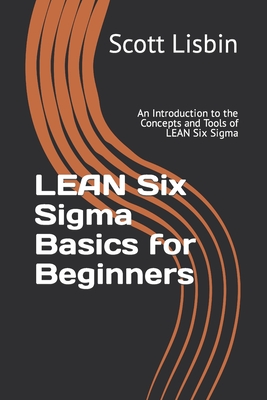Lean Six Sigma Basics for Beginners: An Introduction to the Concepts and Tools of Lean Six Sigma

Lean Six Sigma Basics for Beginners: An Introduction to the Concepts and Tools of Lean Six Sigma
Are you a manager or supervisor that is being asked to do more with less and do it better, safer, cheaper, and/or faster? If so this book is for you ! You will learn from reading this book how to identify, reduce, and prevent any action, activity, variation, and/or expense that does not add "value" for the customer which in LEAN Six Sigma is known as "muda" or "waste". Written in an easy to understand style, "LEAN Six Sigma Basics for Beginners" introduces you to the principles, tools, and techniques of LEAN Six Sigma needed to do more with less and do it better, safer, cheaper, and/or faster. The first chapter provides an introduction to why LEAN Six Sigma is important in todays competitive business environment. The second chapter introduces the concepts of "muda" (japanese for waste) and discusses the 8 different types of waste (defects, waiting, inventory, overprocessing, overproduction, motion, transportation, and human talent). The third chapter discusses how you can identify waste that may be present in your department that may be increasing costs or reducing access, quality, safety, and/or service. This includes discussion of such concepts as value stream mapping, work sampling, SPC control charts, and more. The fourth chapter discusses how to identify the causes of any waste observed in your department. This includes discussion of such concepts as the 5 WHYs, Fishbone and Pareto diagrams, and more. The fifth chapter discusses key principles for eliminating any waste observed in your department including such concepts as poka-yoke, heijunka, 5S, SMED, kanban, and more. A decision matrix is also provided to help you determine which tools to use and when in order to eliminate each of the 8 different types of "waste" observed in your department. This chapter also discusses the various factors (called CSFs or critical success factors) which underlie successful implementation of LEAN Six Sigma concepts. The sixth chapter provides a summary of important concepts and key takeaways from the book. Appendices are provided which offer more detailed explanations for those that are interested in understanding the underlying statistical principles behind LEAN Six Sigma. A glossary of key terms is also provided at the end of the book for quick and easy reference. After reading this book you will have the basic knowledge and tools needed to begin applying the key principles of LEAN Six Sigma in your department or organization in order to do more with less and d
PRP: 156.86 Lei
Acesta este Pretul Recomandat de Producator. Pretul de vanzare al produsului este afisat mai jos.
141.17Lei
141.17Lei
156.86 LeiLivrare in 2-4 saptamani
Descrierea produsului
Are you a manager or supervisor that is being asked to do more with less and do it better, safer, cheaper, and/or faster? If so this book is for you ! You will learn from reading this book how to identify, reduce, and prevent any action, activity, variation, and/or expense that does not add "value" for the customer which in LEAN Six Sigma is known as "muda" or "waste". Written in an easy to understand style, "LEAN Six Sigma Basics for Beginners" introduces you to the principles, tools, and techniques of LEAN Six Sigma needed to do more with less and do it better, safer, cheaper, and/or faster. The first chapter provides an introduction to why LEAN Six Sigma is important in todays competitive business environment. The second chapter introduces the concepts of "muda" (japanese for waste) and discusses the 8 different types of waste (defects, waiting, inventory, overprocessing, overproduction, motion, transportation, and human talent). The third chapter discusses how you can identify waste that may be present in your department that may be increasing costs or reducing access, quality, safety, and/or service. This includes discussion of such concepts as value stream mapping, work sampling, SPC control charts, and more. The fourth chapter discusses how to identify the causes of any waste observed in your department. This includes discussion of such concepts as the 5 WHYs, Fishbone and Pareto diagrams, and more. The fifth chapter discusses key principles for eliminating any waste observed in your department including such concepts as poka-yoke, heijunka, 5S, SMED, kanban, and more. A decision matrix is also provided to help you determine which tools to use and when in order to eliminate each of the 8 different types of "waste" observed in your department. This chapter also discusses the various factors (called CSFs or critical success factors) which underlie successful implementation of LEAN Six Sigma concepts. The sixth chapter provides a summary of important concepts and key takeaways from the book. Appendices are provided which offer more detailed explanations for those that are interested in understanding the underlying statistical principles behind LEAN Six Sigma. A glossary of key terms is also provided at the end of the book for quick and easy reference. After reading this book you will have the basic knowledge and tools needed to begin applying the key principles of LEAN Six Sigma in your department or organization in order to do more with less and d
Detaliile produsului








